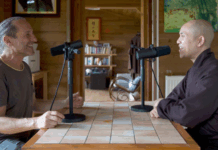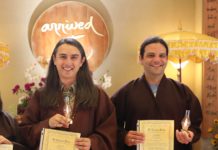Connecting Wake Up and All-Ages Sanghas

By Bryan Hindert
A fellow Wake Upper shared an insight during a recent retreat closing circle. He was surprised to learn some practitioners over forty had many of the same issues that challenged him and his Wake Up friends. It was a moment of connection across generations. I smiled.
The Florida Community of Mindfulness had organized the event. It aspires to be a place where members of all generations can connect, learn from each other, and see we aren’t so different after all; these seeds are beginning to bear fruit. My Dharma journey started with the Florida Community of Mindfulness. In 2013, Fred Eppsteiner encouraged me to reach out to young adults coming to our practice center.
In all honesty, I wasn’t thrilled. I’d been practicing with the Florida Community of Mindfulness for a few years; I was quite happy being one of two or three really engaged young adults there. I’d been making significant transformations in my life. I’d healed much of my own wounding and mental suffering through the practice. Looking back, however, I was avoiding a whole area of my past because of the pain it often brought me. Around other young adults, I’d go into a comparing, jealous, and self-critical mind state. The idea of spearheading a group to invite more young people into our Sangha felt counterintuitive.
Luckily, I had learned through practice that listening to my thoughts was risky business. Fred had taught me that to grow, we can’t be afraid to get uncomfortable. Thus, with Fred’s guidance, and a bit of a nudge, Wake Up Tampa Bay was born.
Before we had our Wake Up group, young adults would visit the Florida Community of Mindfulness, but only once or twice, and then disappear. Once we started having a Wake Up meeting every other Friday night, we would personally welcome them and invite them to our Wake Up group. Young adults continued to come, once they had the ability to connect with people their own age. Over time, our Wake Up group grew from the initial three to twenty or thirty participants—a thriving community of young adults supporting each other in living wholesome, mindful lives. In addition to our Friday evenings, we also offered our own programs: Wake Up Days of Mindfulness, Wake Up Dharma study and practice groups, regular social activities, potlucks, nature walks, and many informal events.
In one sense, the Florida Community of Mindfulness was becoming a more age-diverse Sangha. In truth, however, two separate Sanghas were beginning to emerge. At first, most who came to Wake Up Tampa Bay were also interested in the activities of the all-ages Sangha. However as attendance grew, a shift happened. More and more, the young adults who came to Wake Up seemed satisfied with this Sangha’s peer support. They didn’t seem particularly interested in attending gatherings of the all-ages Sangha. The Wake Up group had been formed as an extra support to younger members in our community; now it had become almost an island unto itself.
This bifurcation of the Sanghas meant that both Wake Up and Florida Community of Mindfulness were missing out on an important connection. A community of practitioners had emerged that nourished and supported mindfulness practice for young adults; nevertheless, our Wake Up community had much to gain from the wisdom and experience of the older, more seasoned practitioners. Moreover, the Florida Community of Mindfulness offered the opportunity to deepen our practice through its many Dharma programs and its connection with a teacher.
Likewise, the Florida Community of Mindfulness could benefit from having the youthful energy of Wake Uppers joining in their activities. We were struck by the realization that our Sangha’s aspirations were out of alignment. We professed to offer an alternative path to the unwholesome elements of our culture. Nonetheless, the Florida Community of Mindfulness seemed to mirror the division and separateness we often found among different age groups in society.
A few Wake Up organizers began a concerted effort to integrate the two divergent groups with Fred’s guidance. The first few years of Wake Up involved creating a space for young people to heal and bolster each other through mindfulness and meditation.
Now, we’re more focused on integrating Wake Up into the larger Florida Community of Mindfulness community. Our intention is to create a unified, truly age-diverse Sangha; in this way we can offer peer support to Wake Up-aged people and still capitalize on the experience of established practitioners.
We’ve experimented with many initiatives, and we’ve needed much encouragement, creativity, and patience. The fruits of this effort are blossoming as more and more Wake Uppers participate in many of Florida Community of Mindfulness’s programs. For instance, almost an equal number of young and more mature adults attended our latest Sangha picnic and a tea ceremony.
Additionally, thirty Wake Up-age participants have become formal members of Florida Community of Mindfulness. We’re still a small percentage of the three hundred Florida Community of Mindfulness members, but we’ve come a long way. We’re also seeing a good representation of Wake Uppers at our weekly Sunday Sangha meditations and Dharma talks. Further, many are taking part in more of the intensive Dharma programs that the Florida Community of Mindfulness offers, working with mentors and taking advantage of Fred’s counsel to guide them in their practice.
Perhaps most telling, this year [in 2018] two Wake Up members took on leadership roles within the larger Florida Community of Mindfulness community. We Wake Uppers are evolving in our practice. We’re discovering a real thirst for deepening our study and engagement with the Dharma. In addition, as more Wake Uppers get to know the older practitioners more deeply, we have developed an eagerness to explore further ways to form ties.
In March 2017, I had the opportunity to meet several Wake Up Ambassadors at a North American Wake Up Caretaking Council Retreat at Deer Park Monastery. I learned that Wake Up Sanghas are watering wholesome seeds in many young adults. These Wake Up groups help them address their difficulties, cultivate joy, be of service to others, develop leadership skills, and begin their Dharma journey. We found that we were not alone; the division the Florida Community of Mindfulness had experienced between its Wake Up group and all-ages Sangha is the reality for North American Sanghas in our tradition.
Our experience in Tampa may be somewhat unique, since the Florida Community of Mindfulness birthed our Wake Up Sangha. Despite our possible uniqueness, it might be helpful to share what we’ve learned during this reintegration process. Our wider Plum
Village community may benefit from these suggestions.
- Ask which of your Wake Up activities meet the particular needs of young people and which aren’t necessarily age specific. Our Wake Up organizers have taken several steps to cultivate a connection with the rest of Florida Community of Mindfulness.
- Host regular “meditations and mixers” where more experienced practitioners are invited to spend an evening with you. You can meditate, share rich dialogue, and commune over tea.
- Invite Dharma teachers to offer Dharma talks and other experienced practitioners to offer presentations and answer questions.
- Discontinue separate Wake Up Days of Mindfulness. Instead, recommend attendance at Days of Mindfulness for both Wake Up Sanghas and all-ages Sanghas.
- Schedule fewer Wake Up-only social events. Rather, promote attendance at all-ages Sanghas social events.
- Set up Wake Up hang out time after an all-ages Sangha activity, such as a work meditation day. We’ve found this gives us the space to connect with our peers while also participating in Florida Community of Mindfulness events.
- Coordinate community involvement activities such as volunteering at a local community farm. Invite the all-ages Sangha to join us.
I encourage my fellow Wake Up conveners to consider the importance of merging Wake Up groups into the all-ages Sangha for the health and well-being of the Plum Village community. The initial development of separate Wake Up groups allowed us to find our own connection to the practice and lineage. After that, the all-ages Sangha profited from our vitality, originality, and excitement for the practice, so all could continue beautifully into the future.
Here is advice for practitioners from the all-ages Sangha who might like to connect with and aid Wake Up groups:
- Ask a Dharma teacher and experienced practitioners to act as close mentors in practice and Sangha-building for your Wake Uppers.
- Host a “Tea with the Teacher” so Wake Uppers can seek guidance in an informal setting.
- Form Dharma study groups led by more seasoned practitioners to enable Wake Uppers interested in going deeper into Dharma teachings and practice.
- Invite older members of the Sangha to treat Wake Uppers to dinners, teas, and other such activities.
In general, I would encourage all-ages Sanghas to understand young adults’ needs to do two things: have space to support each other in the practice and consider how they might bring the mindfulness and meditation into their lives. I advise giving young practitioners a chance to take on responsibility in the Sangha and, when ready, to take on leadership roles. When young adults are given this opportunity, they both step up to the occasion and take more ownership of the Sangha.
These past five years of Sangha building with Wake Up and Florida Community of Mindfulness have helped me untie many internal knots—emotional wounds I’d developed around my peers. The act of doing something meaningful in my life while taking care of and confronting my unhappiness has allowed me to feel whole again. I now enjoy spending time with both younger and older people equally and have Dharma friends of all ages. Through this experience, Fred has taught me to set aside my personal preference; instead, I endeavor do what is most beneficial for the Sangha and for all beings. I have also found a truer joy and well-being than I could have ever found from staying in my comfort zone.
Bryan Hindert, True Legendary Opening, has been following the Buddha’s path since 2008, when he began attending the Florida Community of Mindfulness’s weekly Sangha gatherings. Since then, the Three Jewels have helped him to turn his life around. He is
focused on a career as an organic inspector and is learning to nourish himself through gardening, long walks, and spending time with his wife, family, and friends.
Reprinted with permission from the Mindfulness Bell, Autumn 2018.

















